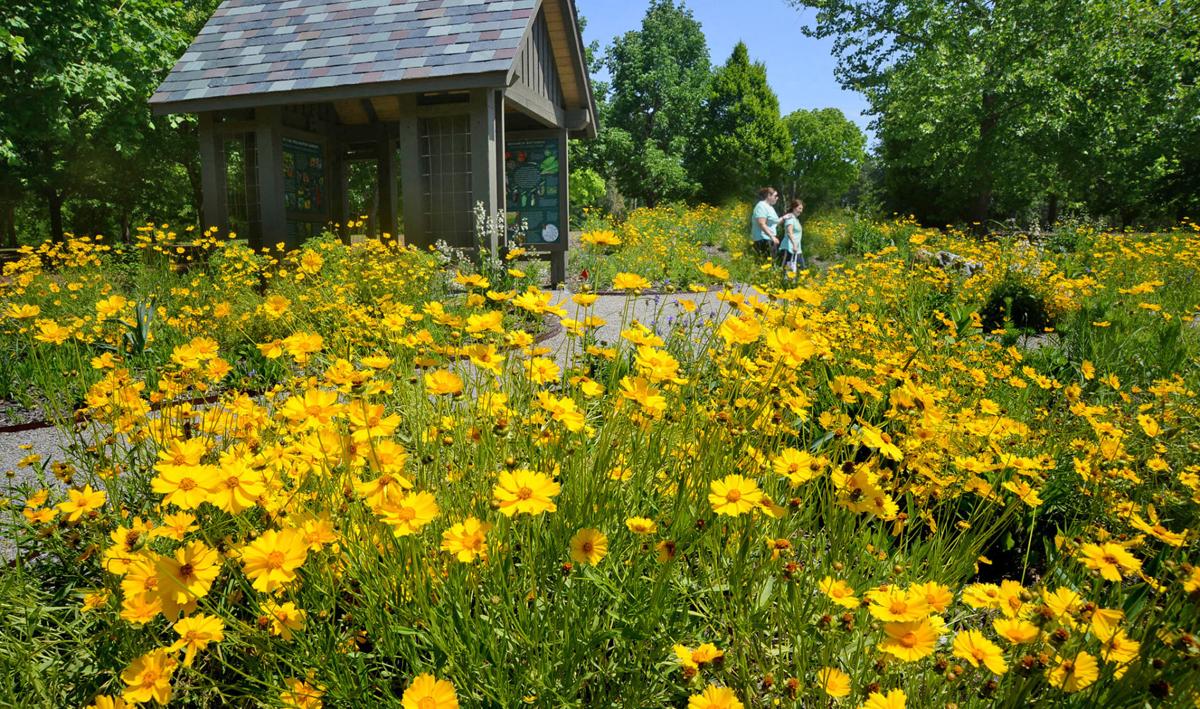The golden-yellow flowers of Lanceleaf Coreopsis create a fantastic display at the Pollinator Garden in the Village Arboretum in Pinehurst. TED FITZGERALD/The Pilot
By Claudia Watson Special to The Pilot 6/16/2020
The brilliantly colored Native Pollinator Garden at the Village Arboretum in Pinehurst is a bevy of activity from any vantage point. Spellbound visitors watch the energetic ballet that takes place among birds, wasps, butterflies, dragonflies, moths, beetles, small mammals and, most importantly, the bees.
“You don’t need to travel far to discover and experience one of the most important ecological processes on earth,” says Beth Franke Stevens, a biologist, and president of the Village Heritage Foundation. “This is a fun and educational opportunity for everyone.”
The first phase of the 10,000-square-foot garden’s installation, completed in April 2019, included native flowering perennials, host plants, walkways, and the Pollinator Pavilion. An ancient river rock serves as a “perch rock” and provides a close view of butterflies “puddling” to soak up inorganic salts and nutrients through their feet.
Lynda Acker, a biologist who is widely known for her understanding of the monarch butterfly’s life cycle, selected plant varieties for the garden. Both Stevens and Acker are dedicated to promoting the health of pollinators through initiatives to create habitat and support conservation.
“Pollinators are essential to our daily life. Without this workforce, our food security is on the line. They provide one out of every three bites of food we eat,” explains Stevens. “Each of us can have a positive impact by creating a habitat that provides pollinators with adequate food, shelter, and water resources as they move through the landscape.”
Pollinators travel from plant to plant, carrying pollen from their bodies and transferring it to plants. That vital interaction results in 90 percent of flowering plants, one-third of human food crops, and one-half of the world’s oils, fibers, and raw materials.
The Native Pollinator Garden offers a rich learning experience for all ages, especially during National Pollinator Week, June 22-28. The nonprofit organization, Pollinator Partnership, www.pollinator.org, provides a variety of educational tools, curriculums, school garden kits, and resources that promote awareness and involvement for all ages.
Last October, the Village Heritage Foundation marked the official opening of Native Pollinator Garden with the Flutterby Festival. The event featured guided tours, pollinator exhibits, and information on creating a backyard pollinator garden. A unique attraction was the monarch butterfly tent, where visitors were surrounded by newly emerged monarch butterflies. This year’s festival, planned for Sept. 12, will be modified to be a socially distant event.
“We can still enjoy the time outside with the flowers, bees, and butterflies that fill our world with beauty and our need for inspiration and hope,” says Stevens, with a smile. “This garden offers us lessons on how to appreciate the natural world outside our front door.”
Reprinted with permission of The Pilot, Southern Pines, N.C., 2020.
For more information, visit, www.villageheritagefoundation.org
Claudia Watson is a freelance writer.

